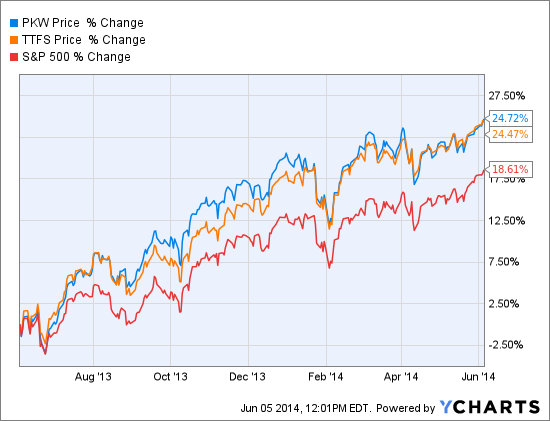Profit from Share Buybacks with This ETF
Post on: 20 Апрель, 2015 No Comment

In the fourth quarter of 2012, companies on key stock indices purchased $93.8 billion worth of their own shares back from investors. This represented an increase of 9.6% compared to the same period in the prior year. For the entire year of 2012, companies spent $384.3 billion to buy back their shares. (Source: “S&P 500 buyback activity flat quarter-over-quarter,” FactSet, April 3, 2013, last accessed May 8, 2013.)
This year looks to be the same—companies on key stock indices are announcing share buybacks. For example, International Business Machines Corporation (NYSE/IBM) authorized another $5.0 billion to its share repurchase program already in place. Adding this amount brings its total buyback program to be valued at $11.2 billion. (Source: Crum, R. “IBM adds $5 billion to buyback plan, ups dividend,” MarketWatch. April 30, 2013, last accessed May 8, 2013.)
Similarly, Apple Inc. (NASDAQ/AAPL) added a massive amount to its buyback program that’s already in place. The company announced it will add $50.0 billion to its share repurchase program, which previously had $10.0 billion in it, bringing its total value to $60.0 billion. Apple plans to complete this buyback operation by 2015. (Source: Rogowsky, M. “Apple’s $50 Billion Buyback Won’t Dent its War Chest,” Forbes. April 26, 2013.)
Some may say buying back shares is like financial engineering. This means that as the companies purchase their own shares back, they don’t necessarily have to earn more to show an increase in their profitability. Consider this scenario: if a company earns $10,000 and has 100,000 shares outstanding, then its earnings per share (EPS) would be $0.10 per share. Now, let’s suppose it purchases 10,000 of its shares back and earns the same amount; the EPS will actually rise to $0.11 per share—an increase of 10% without doing much.
It may be true that it does increase a company’s EPS, but not every company buys back shares with this motive. A company may choose to do this to increase shareholder value, or because it is sitting with a lot of cash and doesn’t really have a place to invest its money.
Buybacks can be great for investors because essentially, it means that the company will be reducing its outstanding shares—all shares ever issued—and therefore the price will increase.
All that said, how can an investor take advantage of share buybacks?
One way they can do this is simply by investing in the companies that have announced share buybacks. A major setback with buying the shares of these companies is that they can become very expensive; for example, if Apple is buying back its shares, it can be difficult for an investor with a small portfolio to take advantage of this phenomenon.
Another way investors can profit from companies that implement a share buyback program is through an exchange-traded fund (ETF) offered by AdvisorShares called TrimTabs Float Shrink ETF (NYSEArca/TTFS). What this actively managed ETF basically does is buy shares of companies that are working to reduce the number of shares they have issued, or their outstanding shares. Although this ETF has a little higher expense ratio compared to others—those ETFs that are managed passively—this ETF provides investors with a fighting chance to profit from share buybacks. (Source: AdvisorShares, last accessed May 7, 2012.)














